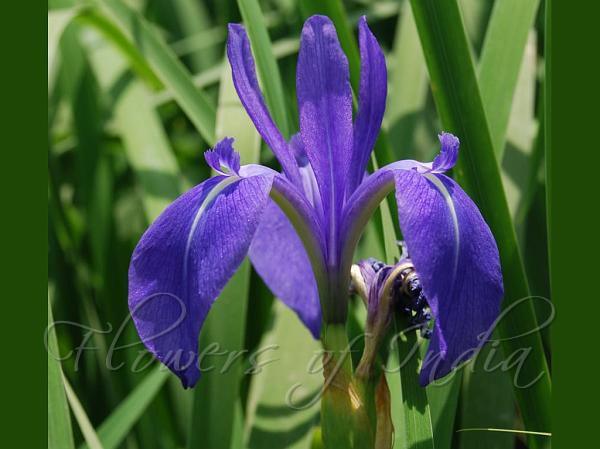|
| Water Iris |
|

|

|
|
|
|
Photo: |
Botanical name: Iris laevigata Family: Iridaceae (Iris family)
Synonyms: Iris versicolor Thunb., Iris albopurpurea, Iris gmelinii
Synonyms: Iris versicolor Thunb., Iris albopurpurea, Iris gmelinii
Water Iris, as the name suggests, is a plant which
grows on marshy land, and on the banks of ponds and streams. It is
famous in Manipur by the name Kombirei. Flowers are dark blue or
violet, 9-10 cm in diameter; flower-stalk 1.5-3.5 cm. Flower tube is
about 2 cm long; outer tepals obovate or elliptic, with a central,
white or yellow zone, limb 7.5-9 x 4-4.5 cm; inner tepals erect,
inverted-lanceshaped, 5-6.5 x 0.8-1.5 cm. Stamens are about 3 cm;
anthers white. Ovary about 2 cm x 5-7 mm. Style branches are 5-6 x
about 1.2 cm; stigmas 2-lobed. Flowering stems are 22-60 cm, solid;
spathes 3-5, very unequal, 6-8 x 1-1.5 cm, 2-4-flowered, proximal ones
shorter, tip usually pointed, distal ones longer, tip usually blunt.
Leaves grayish green, sword-shaped or broadly linear, 40-100 x 0.8-1.5
cm, midvein absent, base surrounded by maroon-brown fibers. Rhizomes
are creeping, thick, about 1 cm in diameter. Capsule is
ellipsoid-cylindric, 6.5-7 x 2--2.5 cm, tip not beaked. Seeds are
brown, semiround, flat, about 6.5 × 5 mm. Water Iris is found in S. Siberia,
Japan to South China, at altitudes of 400-600 m. It is also found in Manipur,
and is a popular flower mentioned in folktales and folk songs.
Flowering: April-June.
| Identification credit: Tabish | Photographed in Lamphelpat, Imphal, Manipur. |
• Is this flower misidentified? If yes,